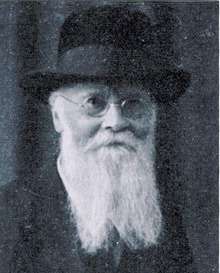Alois Anton Führer
Alois Anton Führer (26 Nov. 1853, Limburg an der Lahn, Germany – 5 Nov. 1930 Binningen, Switzerland) was a German Indologist who worked for the Archaeological Survey of India.[1] He is known for his archaeological excavations, which he believed proved that Gautama Buddha was born in Lumbini, Nepal.[2]

Appointment in India and archaeological activities
Führer came out to India in 1885 and on his arrival Alfred Comyn Lyall appointed him Curator of the Lucknow Provincial Museum. Führer started work in March and immediately set about improving the museum. Impressed by the changes, Lyall, the Chair of the Museum's Management Committee, wrote to Calcutta asking whether a part-time job for Führer could be found with the Archaeological Survey of India.[3] He thus came to hold a double appointment, one as Curator at the museum and the other as Archaeological Surveyor to the North-Western Provinces. As his Progress Reports show, he was part of the N-W.P. and Oudh Circle of the Archaeological Survey.
In 1896 he received permission from the government of the North-Western Provinces and Oudh and the Government of India to carry out an expedition to Nepal. Accompanied by the local Nepalese governor, General Khadga Shamsher, Führer discovered Ashoka’s pillar, an inscription on which, together with other evidence, confirmed Lumbini as the birthplace of the Buddha. This discovery was disputed in a 2008 book by British writer Charles Allen.[4]
Dismissal from government service in India
Führer's archaeological career ended in disgrace. Under official instructions from the Government of India, Führer was relieved of his positions, his papers seized and his offices inspected by Vincent Arthur Smith on 22 September 1898.[5] Confronted by Smith about his archaeological publications and his report to the Government, Führer was obliged to admit "that every statement in it [the report] was absolutely false."[6] These activities were presaged by Führer's publications on Sanskrit texts and law which, as shown by Andrew Huxley, are effectively works of plagiarism, large portions being copied from the writing of Georg Bühler.[7]
Religious life
Führer had an unusual religious career. He served as a Catholic priest but in 1887 converted to Anglicanism. Following his expulsion from government service in India, Führer made plans to become a Buddhist monk. Quoting the Ceylon Standard, the Journal of the Mahabodhi Society noted: "Much interest has been excited in Buddhist and other circles at the prospect of Dr Führer coming to Ceylon to join the Buddhist priesthood. The Press notices recently made regarding this gentleman have given rise to grave suspicion. We understand that Dr Führer will have an opportunity given him of refuting the charges made against him before he is accepted by the leading Buddhists here as an exponent of the religion of Buddha." [8] These plans seem to have come to nothing because in 1901 Führer re-converted to the Christian Catholic Church of Switzerland.[9]
Works
- Führer, Alois Anton (1896). List of Christian tombs and monuments of archaeological or historical interest and their inscriptions in the North-Western Provinces and Oudh, Allahabad: Government Press, N.-W.P. and Oudh
- Führer, Alois Anton, ed. (1909). Śrīharṣacaritamahākāvyam - Bāṇabhaṭṭa's biography of King Harshavardhana of Sthāṇīśvara with Śaṅkara's commentary, Saṅketa, text and commentary with critical notes. Bombay: Government Central Press
- Führer, Alois Anton; Hultzsch, E; Burgess, James (1892-1894). Epigraphia Indica : a collection of inscriptions supplementary to the Corpus inscriptionum Indicarum, Calcutta: Government printing
References
- ↑ "Fuehrer, Alois Anton (1853-1930)". Indologica - Digitalisate (in German). 21 September 2010. Retrieved 2014-03-28.
- ↑ Führer, AA (1897). Monograph on Buddha Sakyamuni’s Birth-Place in the Nepalese Tarai. Allahabad: Government Press, North-Western Provinces and Oudh. pp. 1–48.
- ↑ Huxley, Andrew (2010). "Dr Führer's Wanderjahre: The Early Career of a Victorian Archaeologist". Journal of the Royal Asiatic Society. 20 (4): 489–502. doi:10.1017/s1356186310000246., see note 18 citing India Office Records, Archaeology and Epigraphy, Proceedings 4-18, File no. 6 of 1898, but however add Part B. doi:10.1017/S1356186310000246. The same events with some further details in Charles Allen, The Buddha and Dr Führer (London: Haus, 2008), p. 33 but without supporting references.
- ↑ Allen, Charles (2008). The Buddha and Dr. Führer: an archaeological scandal. London: Haus. ISBN 9781905791934.
- ↑ Willis, M. (2012). "Dhar, Bhoja and Sarasvati: From Indology to Political Mythology and Back". Journal of the Royal Asiatic Society. 22 (1): 129–53. doi:10.1017/S1356186311000794. Smith's report is given in the appendix to this article and is available here: .
- ↑ Willis, M. (2012). "Dhar, Bhoja and Sarasvati: From Indology to Political Mythology and Back". Journal of the Royal Asiatic Society. 22 (1): 152.
- ↑ Andrew; Führer's, Dr. "Wanderjahre: The Early Career of a Victorian Archaeologist". Journal of the Royal Asiatic Society. 20 (4): 489–502. doi:10.1017/S1356186310000246.
- ↑ Anon, Journal of the Calcutta Mahabodhi Society 10.8-9 (December 1901 and January 1902), p. 1.
- ↑ Arx, Urs von (2005). In Marco Jorio, Historisches Lexikon der Schweiz vol. 4, Basel: Schwabe
Further reading
- Huxley, Andrew (2011). "Mr Houghton and Dr Führer: a scholarly vendetta and its consequences". South East Asia Research. 19 (1): 59–82. doi:10.5367/sear.2011.0030.
- Lüders, H. (Jan. 1912 ). On Some Brahmi Inscriptions in the Lucknow Provincial Museum, Journal of the Royal Asiatic Society of Great Britain and Ireland, pp. 153–179 – via JSTOR (subscription required)
- Phelps, T.A. 'Lumbini On Trial: The Untold Story' (2008), http://www.lumkap.org.uk
- Phelps, T.A. 'The Piprahwa Deceptions': Setups and Showdown' http://www.piprahwa.org.uk